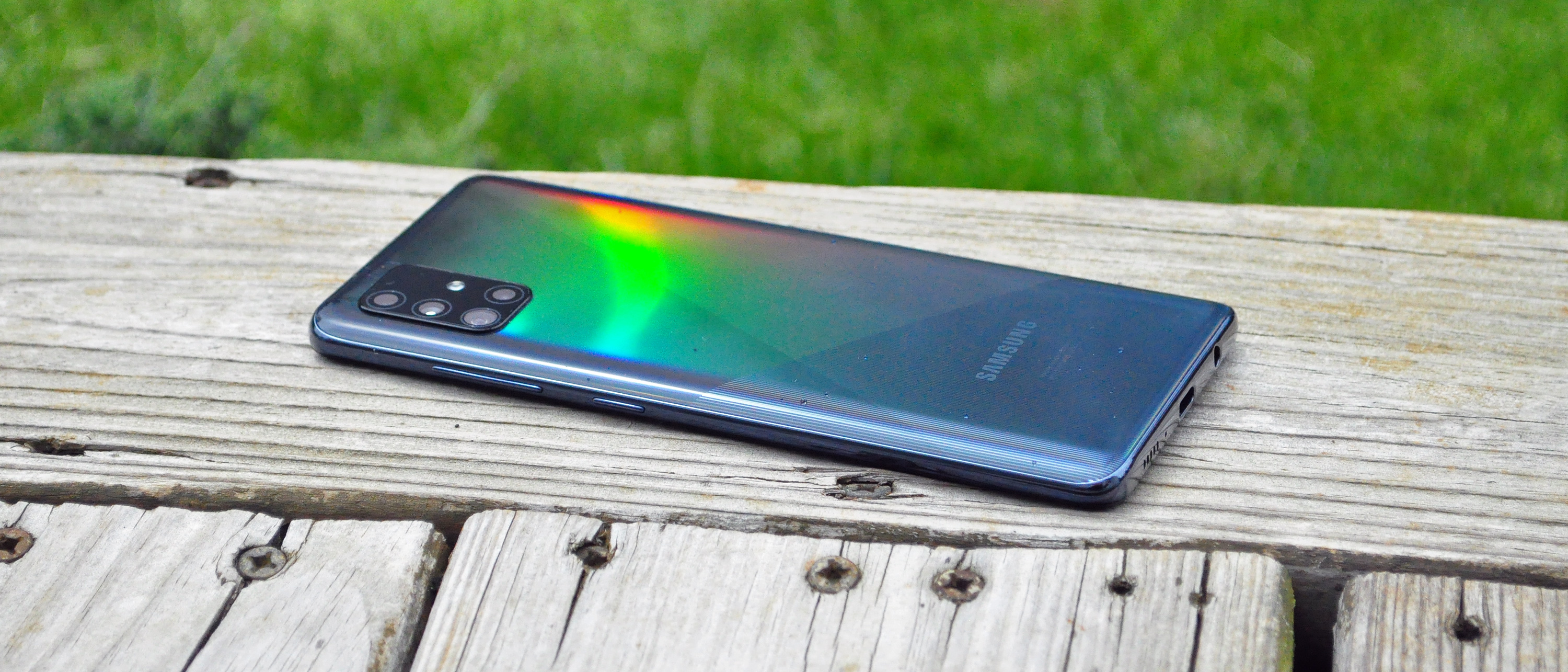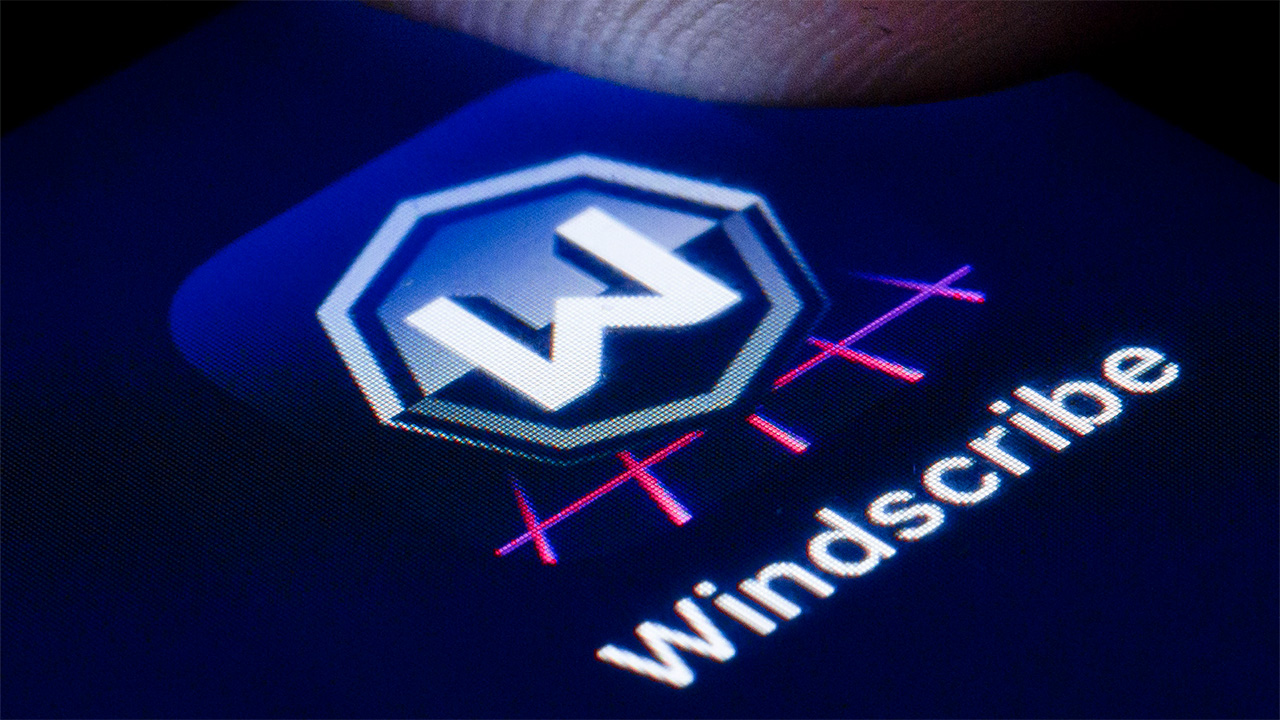Tom's Guide Verdict
The Samsung Galaxy A51 offers a nice design and attractive OLED display, but it’s hamstrung by middling performance, cameras that underperform in low light and relatively short battery life.
Pros
- +
Excellent display
- +
Sleek design
- +
Versatile quad-lens camera
- +
Low price
- +
128GB of storage
Cons
- -
Underwhelming performance
- -
Camera struggles in low light
- -
Battery life could be better
- -
Fingerprint sensor occasionally frustrates
Why you can trust Tom's Guide
Price: $399
OS: Android 10 with One UI
Display: 6.5-inch OLED (2400x1080)
CPU: Exynos 9611
RAM: 4GB
Storage: 128GB; expandable up to 512GB
Rear camera: Quad-lens: 48MP wide (ƒ/2.0), 12MP ultrawide (ƒ/2.2), 5MP depth (ƒ/2.2), 5MP macro (ƒ/2.4)
Front camera: 32MP (ƒ/2.2)
Battery: 4,000 mAh
Size: 6.24 x 2.90 x 0.31 inches
Weight: 6.07 ounces
One look at the $399 Samsung Galaxy A51 and its laundry list of features, and you might wonder why anyone needs a $1,000 Galaxy S20. You get a 6.5-inch OLED display, four rear cameras and a big 4,000 mAh battery for a very reasonable price.
There’s only one problem: Samsung may have stepped up its midrange phone game, but so too has the competition. And while the Galaxy A51 can claim a few advantages over the similarly-priced iPhone SE 2020 and Google Pixel 3a, it still suffers from occasionally subpar performance, low-light photography that often fails to impress, and battery life that’s only decent.
Indeed, this is one of the best cheap phones around; though, as you'll find in our Samsung Galaxy A51 review, it's more of a jack of all trades than a master of one.
Samsung Galaxy A51 review: Pricing and availability
The $399 Samsung Galaxy A51 released on April 9. You can buy it unlocked direct from Samsung, or through a variety of carriers, including Verizon, Sprint, AT&T and Xfinity Mobile. Amazon is also selling the unlocked version.
There’s only one configuration of the Galaxy A51 available in the U.S., and it comes with 4GB of RAM and a generous 128GB of storage. If you need even more space, you can add a microSD card up to 512GB in size.
While $399 is a reasonable price for a phone with all the features the Galaxy A51 boasts, Samsung is running a number of promotions to make it an even better deal. The company is offering up to $220 in credit toward a Galaxy A51 if you trade in a Galaxy S9, Note 9 or older; iPhone X or older; or Pixel 3, 3 XL or 3a. With an eligible trade-in, you can also pay off an unlocked Galaxy A51 over 24 months with zero-percent interest, at $14.58 a month. For a limited time, Samsung is even throwing in a free pair of first-generation Galaxy Buds with every A51 purchase.
One word of advice for shoppers: Be wary of alternate Galaxy A51 models circulating around retailers across the web. If the price seems to good to be true, chances are you're probably looking at the Latin American or international variant, rather than the U.S. edition tuned for domestic networks.
Get instant access to breaking news, the hottest reviews, great deals and helpful tips.
Samsung Galaxy A51 review: Design
Lots of phone makers like to tout how their flagship designs trickle down into more affordable midrange models, and Samsung is making similar noises about the Galaxy A51. However, in a shocking twist, I’ve found I actually prefer the A51’s look and feel to its Galaxy S20 extended family.
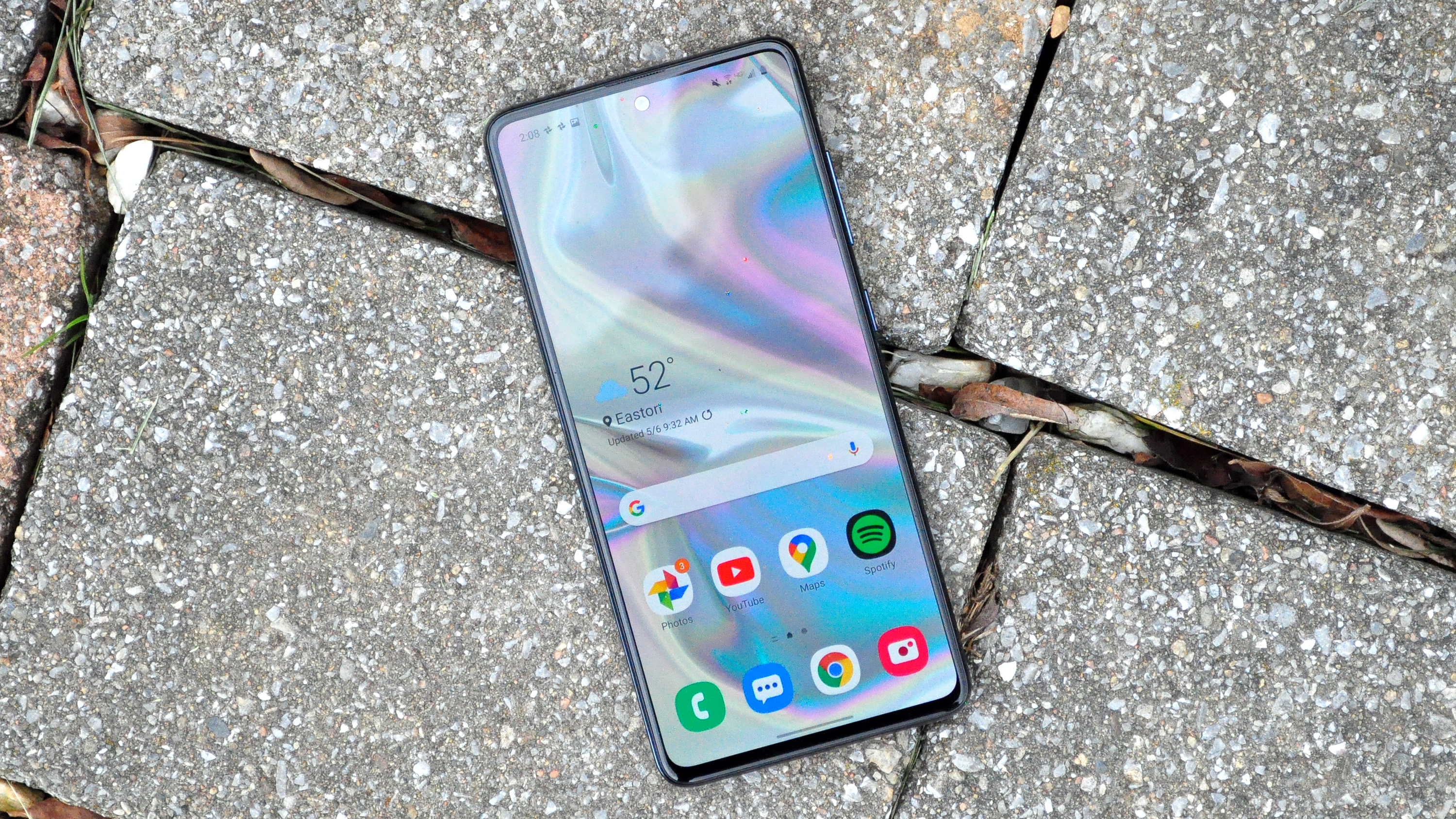
There are several reasons for that. First, the A51 is light — really light. Samsung has always done a good job of building featherweight phones that still feel well made, and the A51 is indicative of that. Its 6.5-inch display is nearly two inches larger than the 4.7-inch panel inside Apple’s new iPhone SE, and yet the A51 only tips the scales at 0.8 ounces heavier. Holding them each in one hand, you can tell the Galaxy is a smidge heftier, but not by nearly as much as you might assume.
Second, the A51’s display is flat, which is actually a breath of fresh air from the curved panels inescapable in every modern premium handset. It’s hard to put my finger on, but a flat screen simply feels simpler to use and easier to live with. Some curved panels look weird head-on (e.g., Motorola Edge Plus) while others are magnets for unintentional taps, made worse by poor palm-rejection software (e.g., OnePlus 8 Pro). But the A51 is attractive, with its super-slim bezels and a display that perfectly follows the silhouette of the body. Those aspects in particular truly make it feel like a pricier phone than it is.
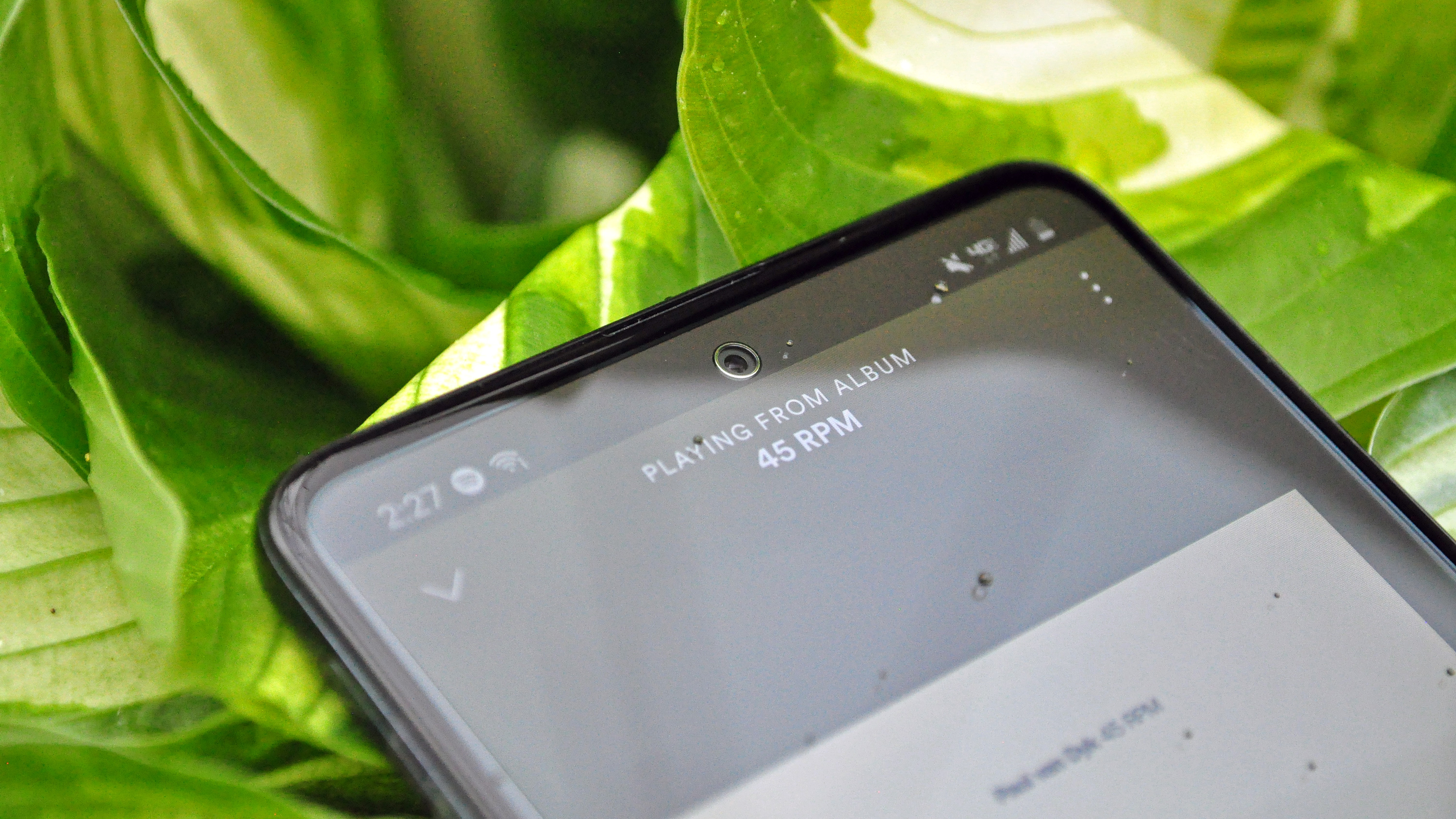
But it gets better: the A51 has a headphone jack — something you won’t find on Apple’s cheap new iPhone. Unfortunately, though, it's not IP-rated water resistant; in fairness, that's a rarity at this price point.
I have but two small criticisms of the A51’s design. First, while the iPhone SE and Pixel 3a both pack stereo speakers mounted in the earpiece and the bottom of the frame, the A51 routes all audio through the latter. It’s not a dealbreaker at this price, though it does lead to that classic problem of muffling sound when cradling the phone in your hands sideways as you play a game.
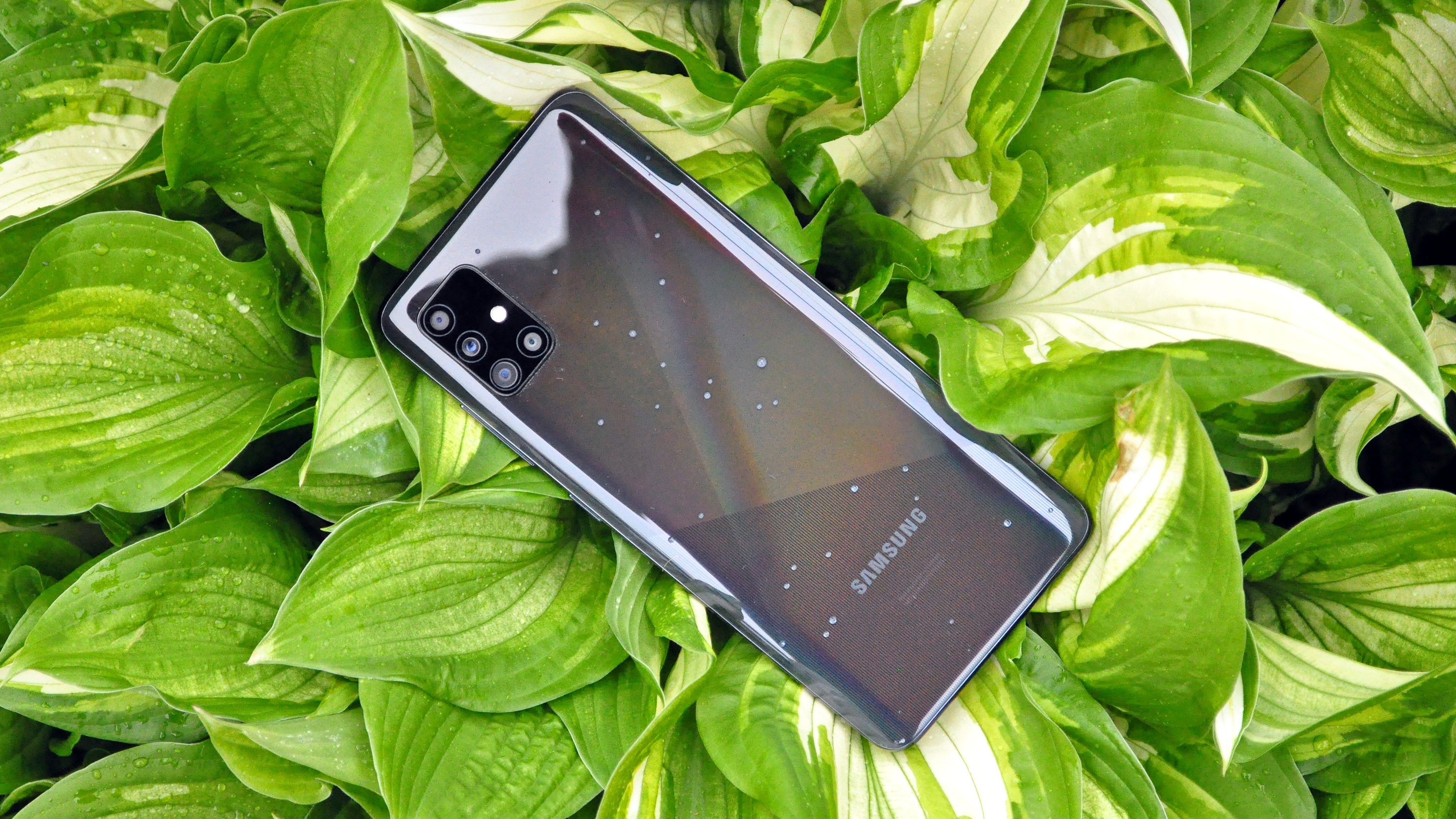
Second, the materials that comprise the A51 don’t feel cheap, though they’re no replacement for the glass-and-metal iPhone SE, or the partially matte-textured Pixel 3a.
Samsung actually has a name for what it uses on the back — it’s officially known as “glastic” — and I’m pleased to say it feels more like actual glass than that groan-eliciting name might lead you to believe. I don’t even mind the subtle iridescence of our Prism Crush Black review unit. Usually, that sort of thing registers as gaudy to me, though the A51 doesn’t catch light in an obnoxious way. However, I could do without the frivolous lines and triangular designs on the back, as it’s a constant reminder of the phone’s budget roots.
Samsung Galaxy A51 review: Display
One of the best things about last year’s Galaxy A50 was its AMOLED display — a luxury typically reserved for more premium devices. The new Galaxy A51 retains that dazzling panel, except this time it measures 6.5 inches from corner to corner, while keeping a full-HD resolution.
All OLED panels are not created the same, and so the Galaxy A51’s screen can’t quite match the astronomical peak brightness or high dynamic range of the displays in the Galaxy S20 series. The A51 tops out at 565 nits of full-screen brightness, which is quite high — though you’ll only see that kind of luminosity outdoors, under harsh sunlight. Ordinarily, the highest manual setting leaves you at about 353 nits, which is a lot dimmer than the iPhone SE’s 653 nits maximum.
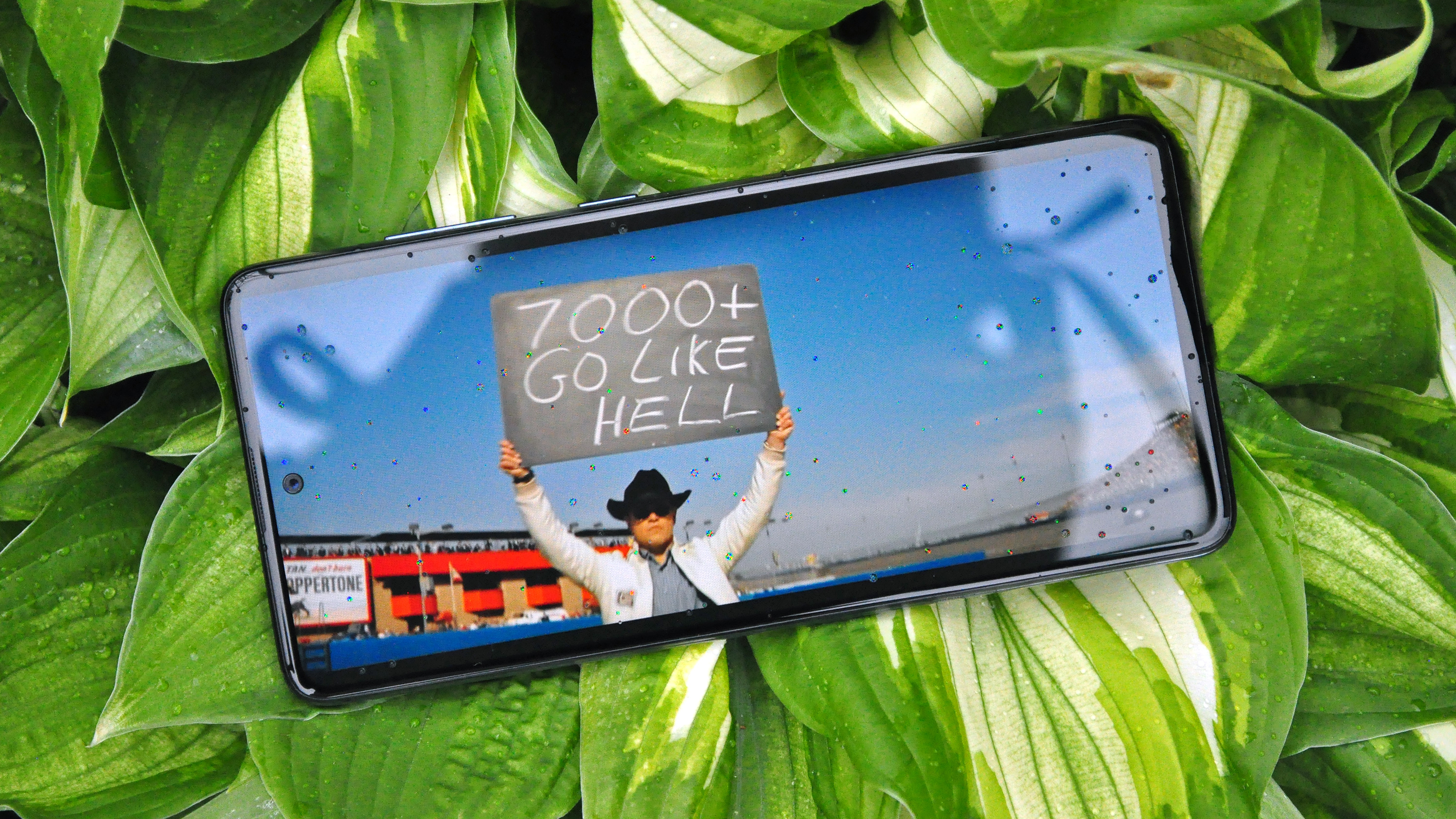
But then, of course, the iPhone SE’s display isn’t OLED — it’s LCD. And because the iPhone’s screen is LCD, it can’t deliver the robust hues and deep blacks that the A51 routinely churns out.
Watching Ken Miles’ epic final laps in the film Ford v Ferrari on the Galaxy A51, I was impressed by the sunlight breaking through the trees lining Le Mans’ Arnage corner, bathing the treetops in a warm glow while leaving the forest depths suitably murky. I’ve become used to observing that kind of contrast in flagship phone panels, but it’s not something I ever expect to see from devices as inexpensive as this Galaxy.
On its default Vivid setting — which is extremely saturated, it has to be said — the A51 rendered 212.2% of the sRGB color space, compared to the iPhone SE’s 111.2% and the Pixel 3a’s 182.3%. The A51’s Delta-E color accuracy takes a hit under the Vivid profile as well, as Samsung’s phone registered a Delta-E score of 0.30 under our light meter, compared to the respective 0.20 and 0.18 scores of Apple and Google’s budget handsets. (Numbers closer to zero are better in the Delta-E test.)
Samsung Galaxy A51 review: Camera
You might expect one or two cameras from a $400 phone, but the Galaxy A51 has a whopping four on the back: a 48-megapixel, ƒ/2.0 wide-angle primary shooter, supported by 12MP ultrawide, 5MP depth and 5MP macro optics. A 32MP sensor serves selfie duties on the front.
That’s a whole lot of megapixels, and when conditions are favorable, the A51 can pull in a lot of detail, and churn out shots that compare favorably against the iPhone SE's best work. Samsung’s Live Focus mode isn’t restricted to people, like Apple’s Portrait Mode is, so you can get shallow depth-of-field shots of anything — even this lantern. Overall, the iPhone’s white balance and lighting is more realistic here, though I do like the A51’s depth effects, even if some details on the fringes of the lantern are blurred erroneously.
That ultrawide shooter shines when the sun does, too. The iPhone SE lacks a lens with a similarly all-encompassing perspective, and so iPhone owners are at a loss to capture shots like this one of a backyard the A51 delivered. Apple’s device also went for a strangely warm cast here, which doesn’t ring true given the conditions. The shot from the Galaxy device isn’t perfect — the shed on the right is totally blown out, for example — though there’s a surprising level of detail overall in Samsung’s shot, and good dynamic range as you move from the shadows to daylight.

I was even impressed by the A51’s macro camera — an optic that’s easy to overlook, given the quantity on this device. I was able to get astonishingly close to these lilies, and the result was more crisp and simultaneously less noisy than I anticipated. If I have one gripe, though, the macro lens does have a habit of bleeding color out of scenes, because both this and another image I captured of lavender suffered from slightly drab, undersaturated hues despite the sun shining outside.
By now though, you may have noticed the qualifier that keeps popping up with every comparison: the A51 needs ideal lighting to take decent shots. Case in point, the example you see below, which was captured at dusk.
First off, I have to stress how poor the A51 is at focusing in low light; while the iPhone SE easily locked onto the plant without me having to lift a finger, the A51 made no attempt to adjust its gaze, and tap-to-focus didn’t work either. I had to keep moving the Galaxy back and forth to ascertain any kind of lock, and when I did, I ended up with the shot you see above.
I was also able to get much closer to the flowers with Apple’s device. While the A51 has that aforementioned macro shooter, it only works at a distance of millimeters; conversely, if I tried to draw any closer with the primary lens, the shot you see above would have turned out blurrier than a Monet painting. I’ll concede that the A51’s photo is obviously brighter, but if you look closely, it’s marred by absurdly bold colors that don't mesh with the actual lighting outside, as well as excessive grain. Neither of those issues plagued the iPhone’s rendition.
What about night shots? Well, you’d think the A51 would be better equipped for such scenarios, because it has a night mode — something Apple’s cheapest iPhone lacks. As I discovered though, it’s not very useful. In complete darkness, the shots it captures are totally unusable — smeary globs of grays that comprise fodder for horror films. In other instances, like the example above, the Night Mode just doesn’t make much of a difference.
Even without a similar setting, the iPhone SE turned in a sharper shot, with more natural color that didn’t render the shadows a dim blue. There’s slightly more visibility overall from the A51’s version of things, and the light beaming outdoors from the window is brighter, but as a tradeoff, you actually lose some detail in the pink curtains.
Indoors, things didn’t get better for the A51. Its rendition of various things atop my desk was washed out next to the iPhone’s more-precise, less-noisy take. The purple book has a distinct texture that the Galaxy totally fails to convey, and every last drop of color has been squeezed out of its cover. Instead of several mediocre cameras, perhaps Samsung would have been better off giving the A51 one or two very good ones.
Finally, we turn to the selfie side-by-side, which again illustrates that while the A51 is capable of producing sharp photos, it also has a tendency to do strange things with color. Not only is the entire frame oddly cool, but my hat is the wrong color, and the trees in the background seem to have lost most of their needles against the blown-out sky.
Samsung Galaxy A51 review: Performance
Rather than using one of Qualcomm’s midrange 600- or 700-series chipsets, the Galaxy A51 derives its power from Samsung’s own Exynos 9611 CPU and 4GB of RAM. The 9611 is an 10-nanometer, octa-core processor, and its closest competitor is probably the Snapdragon 665, which happens to feature in the just-launched Moto G Power.
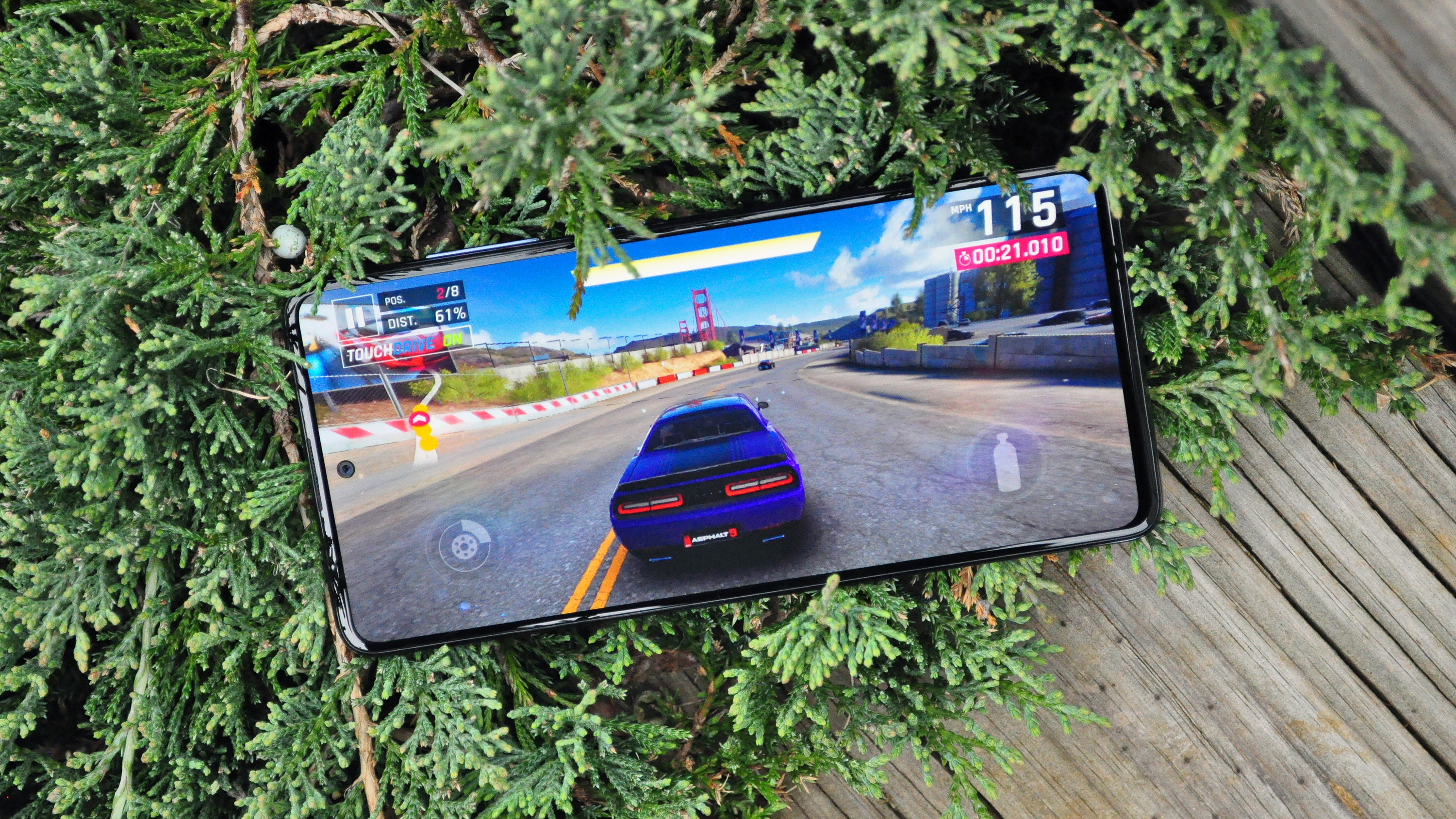
Mid-tier silicon like the 9611 should suffice to handle all but the most demanding games, and perhaps you might expect it to be flustered by frequent app switching when a lot of tasks are going on concurrently. Strangely though, the A51 seems to excel at games — for a budget handset, anyway — while struggling with the simple stuff, like opening apps and rotating orientation when moving in and out of videos.
While Asphalt 9 Legends doesn’t run quite as smoothly on the A51 as it does on one of Samsung’s flagships, and while you will notice a slight hit to the resolution and anti-aliasing, it’s not as drastic a slump as you’d think. I was still able to take out competitors and drift to victory, even despite some dropped frames here and there. PUBG Mobile also looks crisp and fluid in motion on the A51, and I was surprised to see the battle royale shooter default to high settings the first time I tried it out on this device.
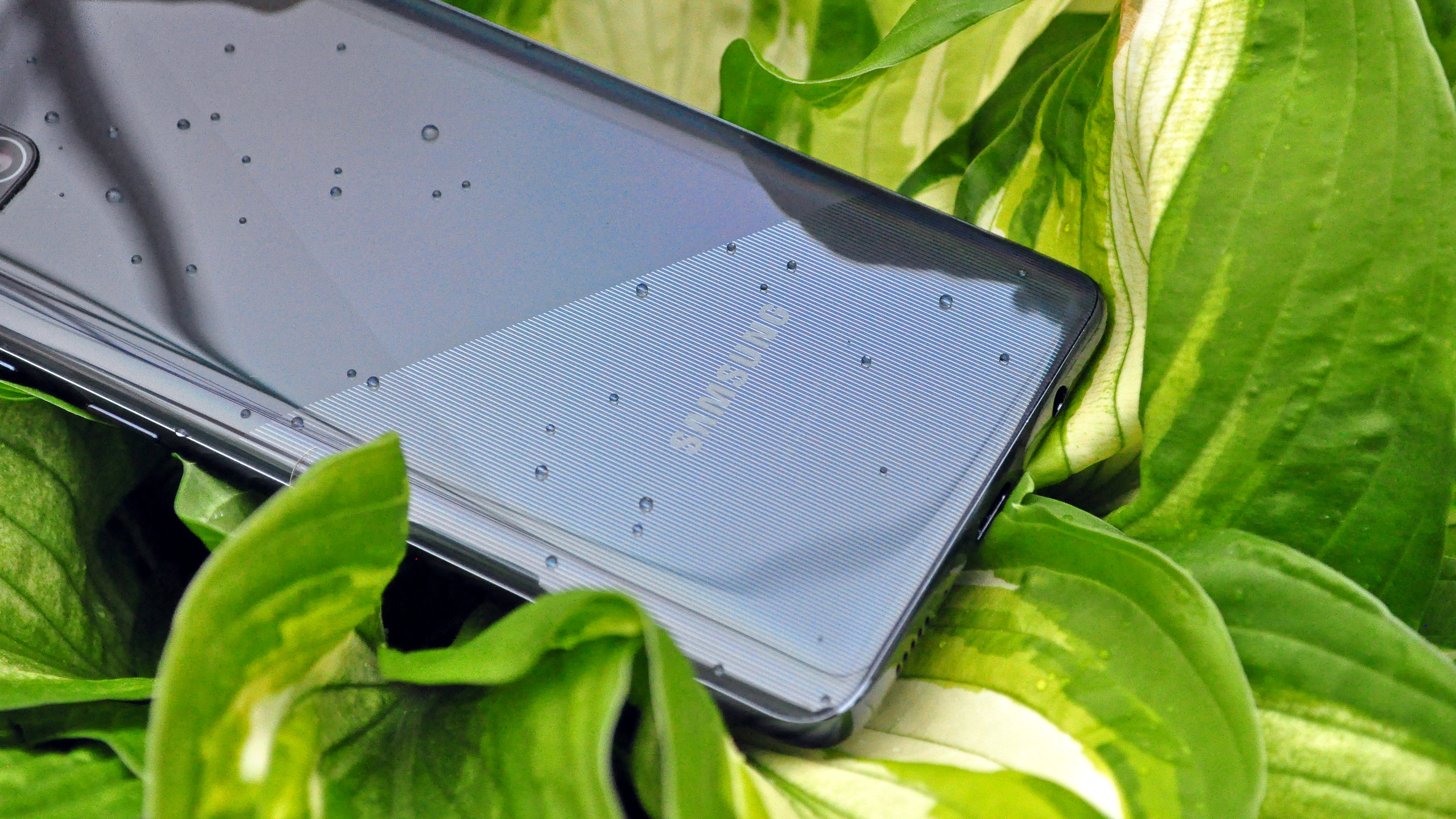
But then, you’ll go to do something routine on the Galaxy A51, like open Chrome or swipe up to reveal the app drawer, and there will be a delay, or an animation that stutters unexpectedly. Scrolling through restaurant listings in Google Maps feels sluggish at times, and the camera typically hesitates to launch unless it’s recently been opened.
Some of these annoyances have been typical of cheap phones in the past, but they’re harder to excuse given the recent competition in the segment. The new iPhone SE feels every bit as responsive as an iPhone 11 Pro, given that it utilizes the same A13 Bionic processor. You can see more details in our Galaxy A51 vs. iPhone SE face-off. Meanwhile, the Pixel 3a’s user experience is comparable with that of Google’s flagships. Using the A51, I couldn’t help but think that a $400 Galaxy phone should be snappier than this.
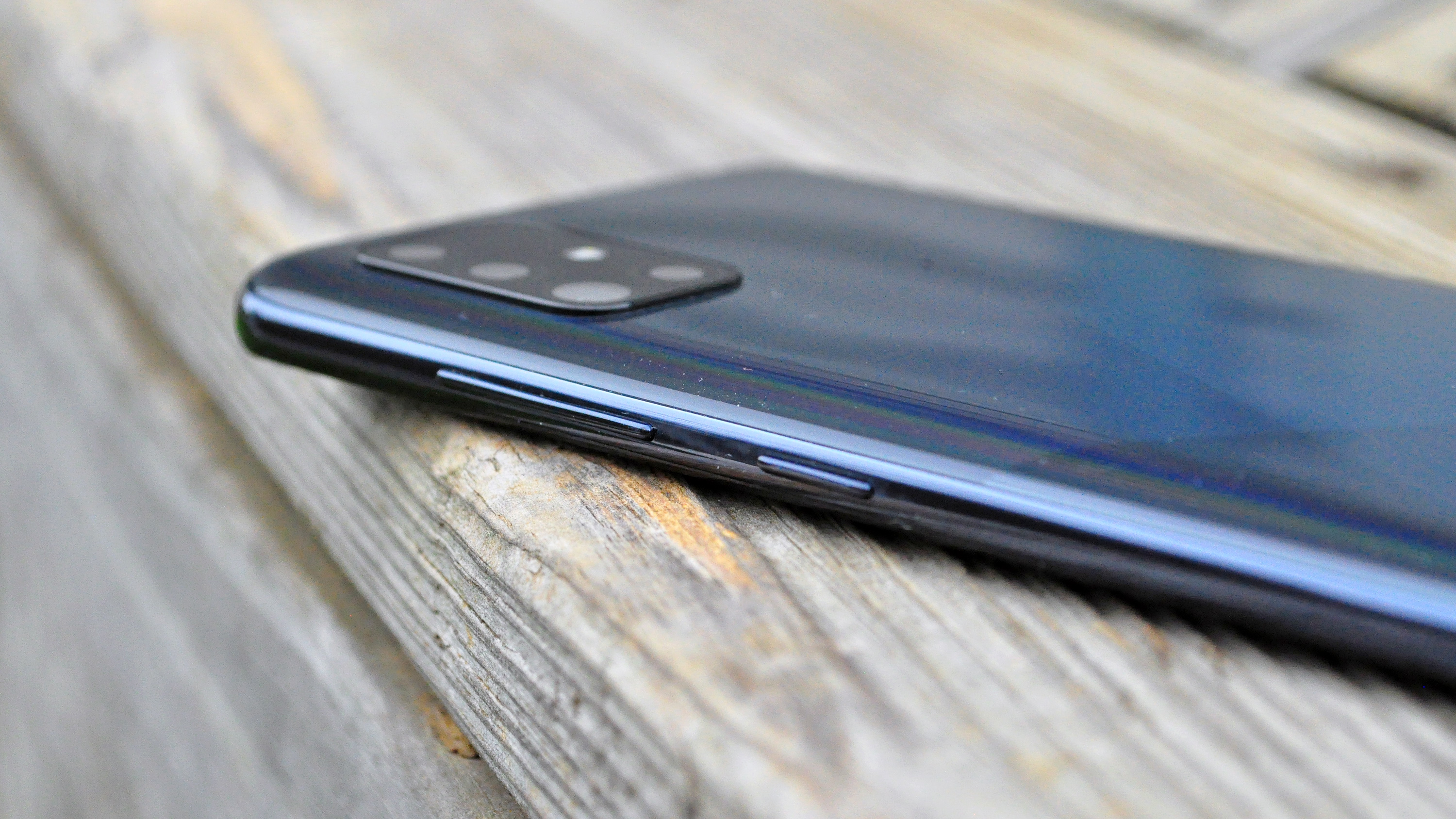
The benchmarks illustrate the problem. The Galaxy A51 managed a score of just 1,293 in the multicore Geekbench 5 test. The Pixel 3a from last year beats it, at 1,336, while the $249 Moto G Power turned in a respectable 1,387. (It’s almost unfair to highlight the iPhone SE’s result here, but if you’re curious, it was 3,226.)
The A51’s showing in 3DMark’s Sling Shot OpenGL ES 3.1 graphics test was a bit better. There, Samsung’s device totaled 2,057 points, nearly splitting the Moto G Power’s 1,734 and the Pixel 3a’s 2,543 scores. Ultimately, this budget Galaxy’s performance isn’t poor enough to be a dealbreaker, though prospective buyers should note that some other phones in this price range don’t force you to compromise in the same way.
Samsung Galaxy A51 review: Battery life
Samsung has shoehorned a 4,000-mAh battery into the Galaxy A51, which seems quite large considering how slender this device is. That big battery, plus the A51’s hardware being optimized more for efficiency than all-out power, should guarantee exceptional battery life — or so you'd think.
Yet the A51 averaged just 9 hours and 16 minutes in our custom battery test, where devices endlessly load webpages while set to 150 nits of screen brightness, until they eventually run out of juice. The handsets on our best phone battery life list top 10 hours.

The A51’s runtime is below average for smartphones these days, though it happens to be in line with the new iPhone SE, which endured two minutes longer in the same test. However, even that's not very encouraging, once you consider that the iPhone’s battery is less than half the capacity of the A51’s.
The battery story gets worse as you begin comparing the A51 to its Android contemporaries. The Pixel 3a lasted 11:59, while the new Moto G Power turned in a whopping 16:10 with its 5,000-mAh battery. This Galaxy’s longevity isn’t awful, though, much like its general performance, it’s not nearly as impressive as you’d hope it to be.
Samsung packs a fast charger in with this phone, but given the size of the battery and the brick’s 15-watt speed being rather inadequate to push all that juice, it’s really fast in name only. Over the course of a half hour, our review unit went from zero to just 31% — again, a pretty unremarkable result.
Samsung Galaxy A51 review: Software and special features
The Galaxy A51 comes out of the box with Android 10 installed, and on top of that you get Samsung’s One UI. Although I’ve never been one for phone makers’ user interface tweaks to Android, One UI is a pretty comprehensive package that is more than just a reskin, adding useful features that you don’t often see in phones as cheap as this, like the ability to capture scrolling screenshots and store media in secure, password-protected folders.

Rather than use a rear-mounted fingerprint sensor, the A51 incorporates an in-display optical scanner that works well most of the time — though it requires a little patience. It’s not immediate like the capacitive sensors of old, and it can be a little finicky, particularly if you’ve just washed your hands. Optical sensors can’t deal with moisture, and so the A51’s isn’t unusual in that regard. Nevertheless, even if you’ve dried your hands well, the A51’s sensor seems to be particularly sensitive to even the slightest degree of dampness.
Samsung has committed to two years of software updates and support for the Galaxy A51, and plans to issue security patches on a quarterly schedule, unlike the monthly basis of its premium Galaxy S- and Note-series devices. That’s actually better than what most Android phone makers typically do for their lower-cost models, though it doesn’t quite equal the three years of updates Google provides for its Pixel devices — let alone Apple’s unparalleled support timetable for its handsets.
Samsung Galaxy A51 review: Verdict
On paper, the Samsung Galaxy A51 would seem like the best cheap phone $400 can get you. It has a phenomenal display for the money; a gigantic battery; a processor that seems fast enough; and a quad-lens camera system that gives you more versatility in shooting than its single-lens rivals from Apple and Google.
But once you dig past the spec sheet, the flaws start to reveal themselves. The A51’s display is pretty, but not bright; its battery is big, but doesn’t last as long as the big batteries in other phones; its processor gets randomly flummoxed by basic tasks; and all those camera lenses provide many perspectives, but not a whole lot of quality.

Thus, our Samsung Galaxy A51 review found a generally good phone, but a difficult one to recommend when the competition offers more.
Sure, the iPhone SE looks positively dated next to Samsung’s offering, but it’s hard to argue with all the power in Apple’s device, and the impressive photos it can churn out. The same can be said of the Pixel 3a’s camera; Google’s phone also lasts longer on a charge than the A51, and will soon be replaced by a successor that will probably be even better overall. And if it's battery life you want, well, you can’t do better than the $249 Moto G Power right now, which features a processor that actually compares impressively to the one inside the A51.
That leaves this Galaxy in a tough spot. The A51 is a phone I wanted to love — I was impressed by its design from the moment I took it out of the box, and it’s encouraging that we’re reaching a point where you can get such a large OLED screen and 128GB of storage in a device for less than $400. Yet, as solid as it is, you get the sense something’s missing here.
Adam Ismail is a staff writer at Jalopnik and previously worked on Tom's Guide covering smartphones, car tech and gaming. His love for all things mobile began with the original Motorola Droid; since then he’s owned a variety of Android and iOS-powered handsets, refusing to stay loyal to one platform. His work has also appeared on Digital Trends and GTPlanet. When he’s not fiddling with the latest devices, he’s at an indie pop show, recording a podcast or playing Sega Dreamcast.
